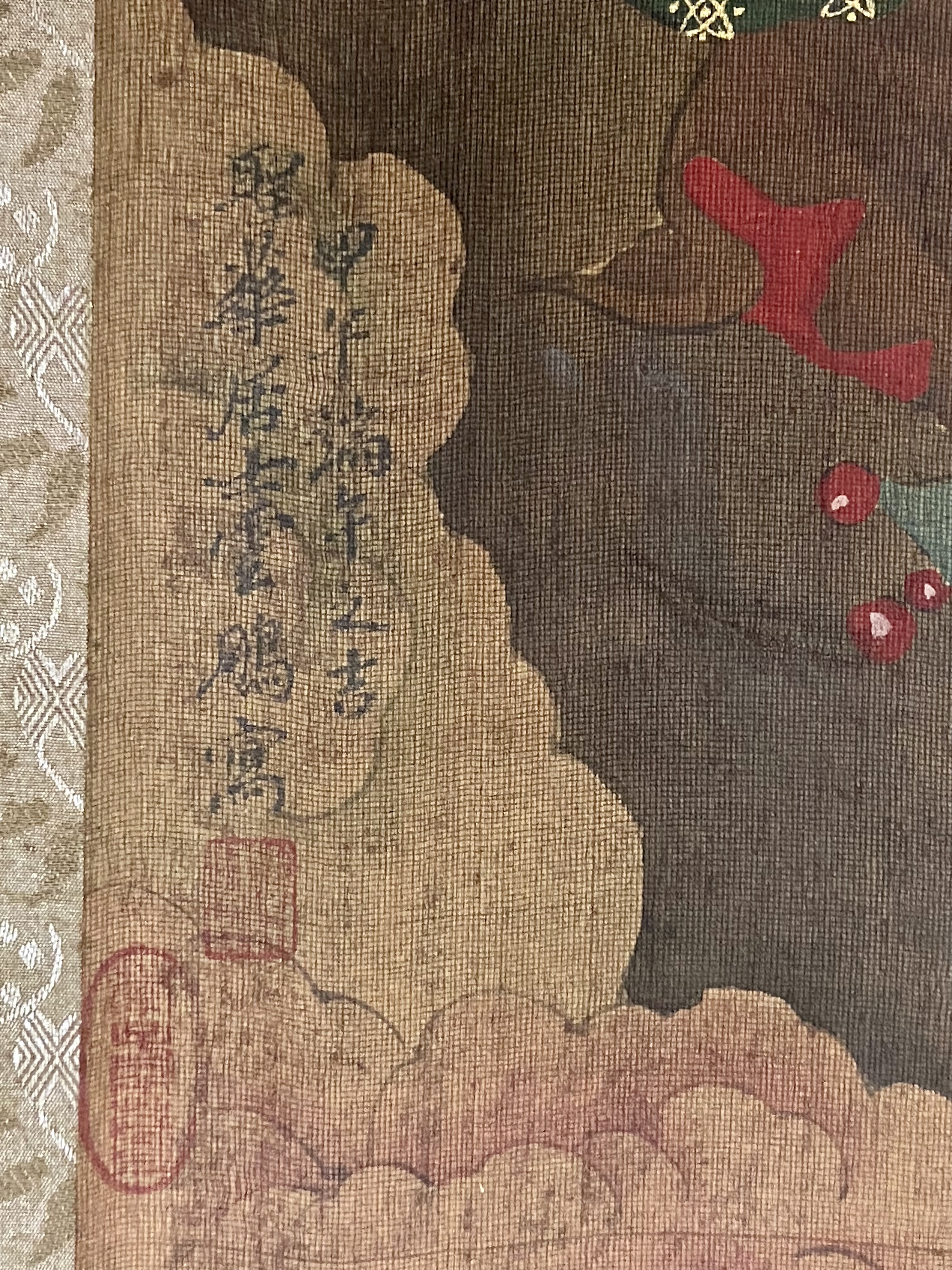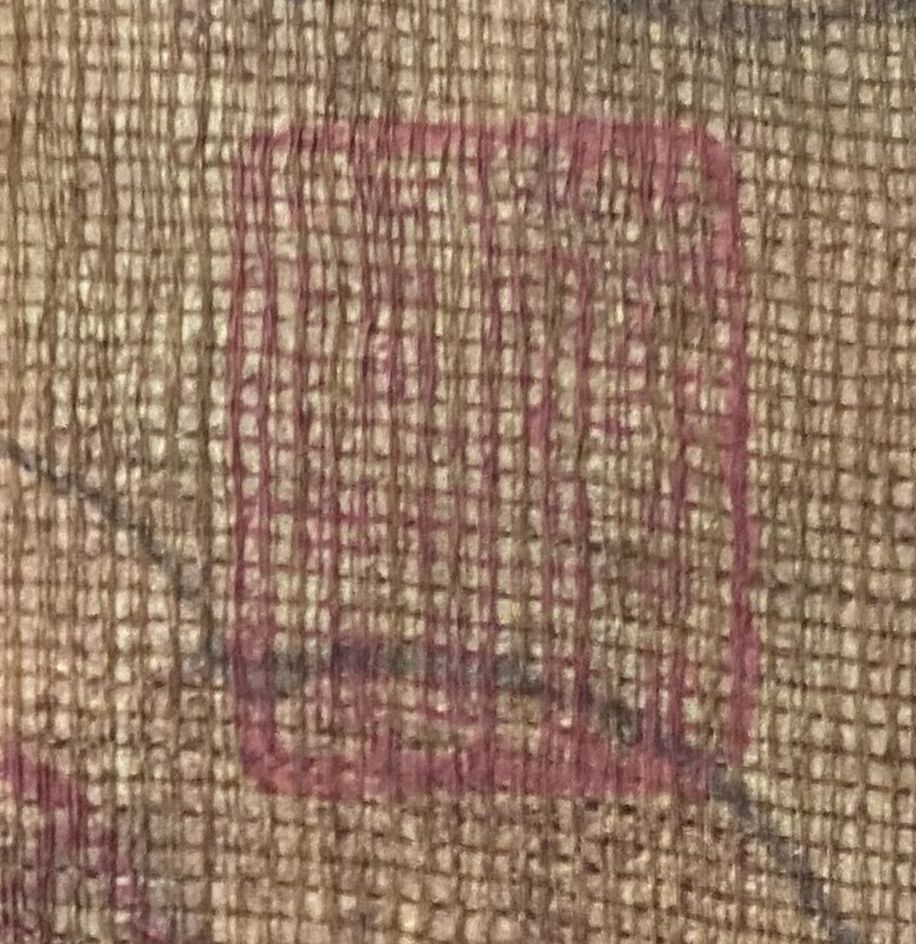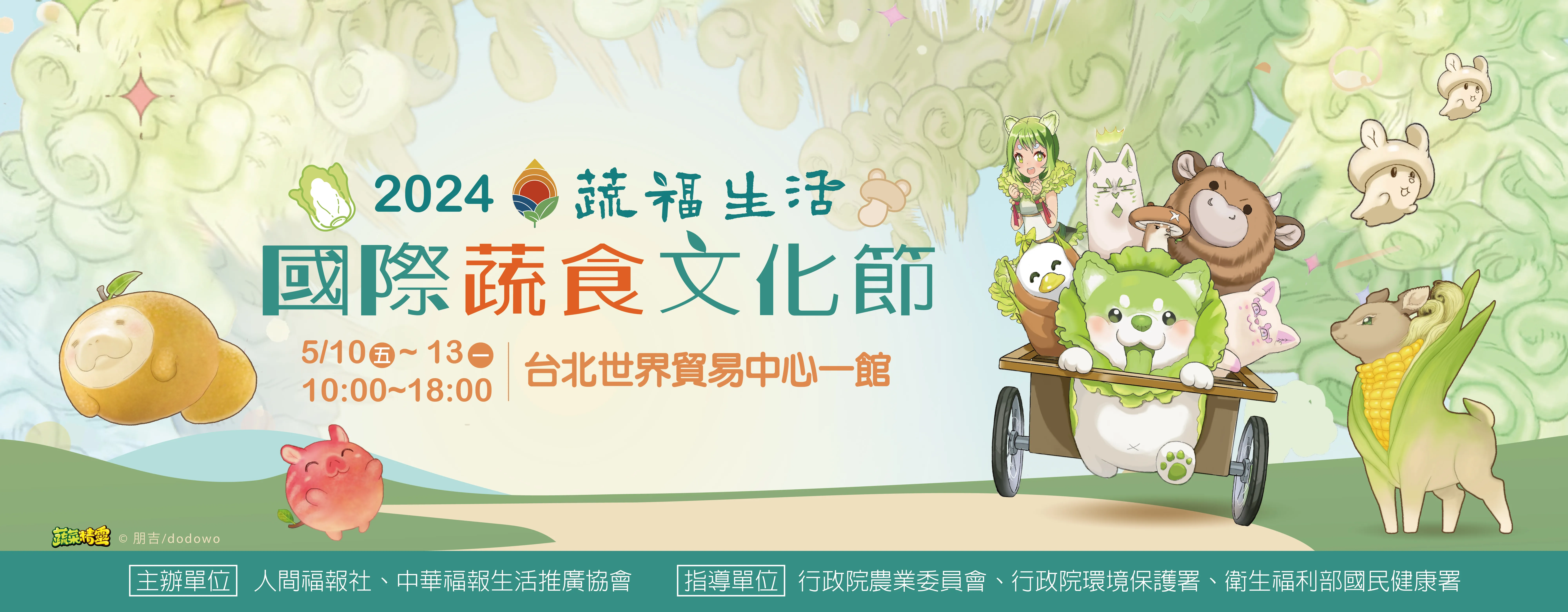
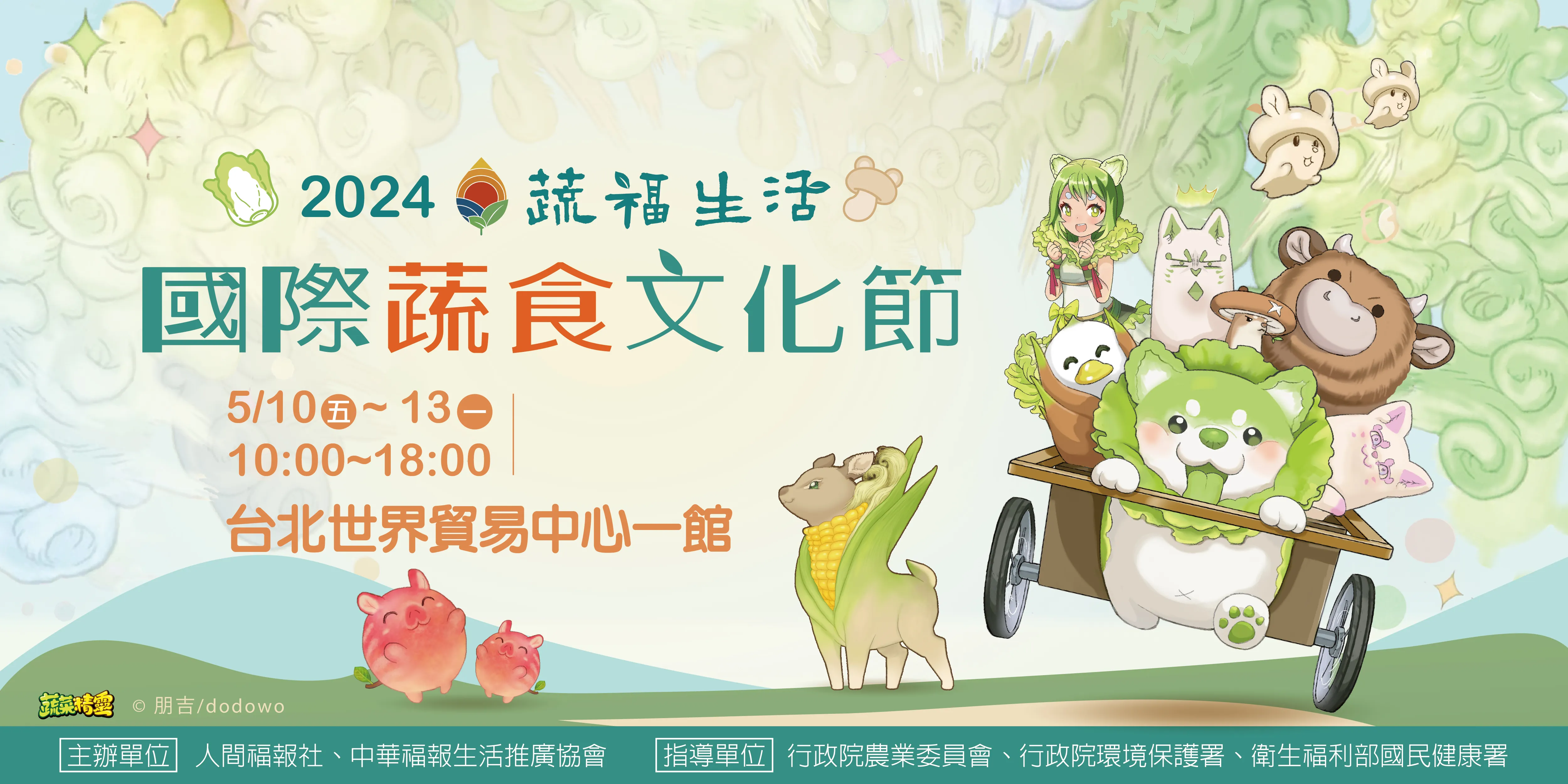
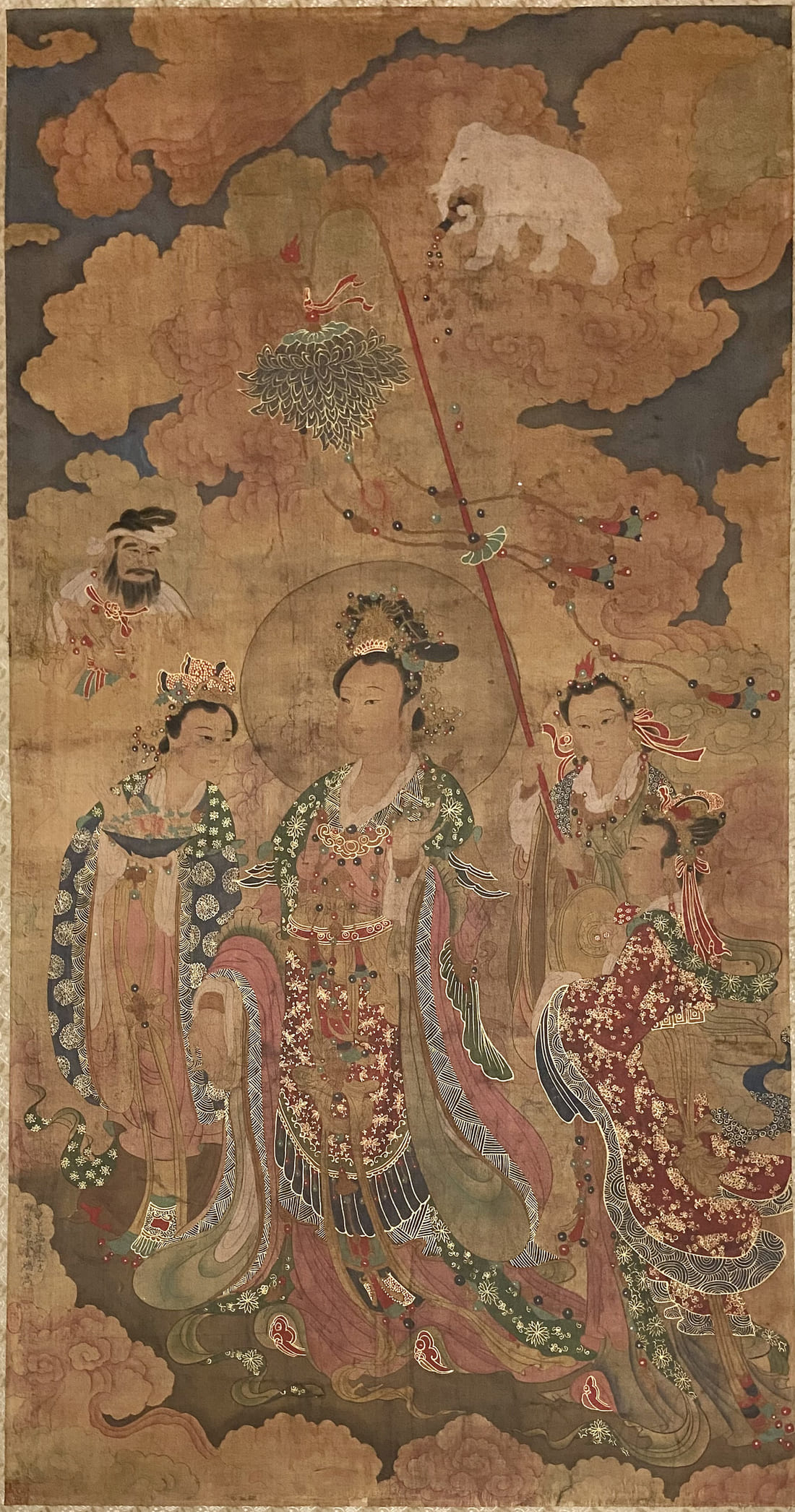
| 時代: | 明朝中後期(西元1594年) |
| 出土地點: | 傳世品 |
| 尺寸: | 長度:約166.5 cm 寬度:約86.7 cm |
| 質地: | 工筆礦物彩絹布畫作 |
| 數量: | 1 |
此幅畫主體為普賢菩薩與侍者,畫面正中央為普賢菩薩,普賢菩薩頭戴冠,臉頰豐腴、耳垂長,頭部比例較大,上半身面積稍大,著有綠色披肩、繁複華麗的天衣,衣著蔽體不露,在寬大袖口自手肘才大幅散開,胸口處白色領口衣紋動態自然,衣著有描金花卉紋飾,左手向上、拇指與食指相捻,持說法印,右手向下、掌心朝外持與願印。
The central subject of the painting is Bodhisattva Samantabhadra and attendants. In the center of the composition stands Bodhisattva Samantabhadra. The bodhisattva wears a crown, has plump cheeks, and elongated earlobes. The head is proportionally larger, and the upper body occupies a slightly larger area. The bodhisattva is adorned with a green shoulder mantle and a complex, splendid celestial robe that covers the body without exposing it. The wide sleeve cuffs open substantially below the elbows. The dynamic and natural white neckline pattern at the chest adds to the attire's intricacy, with intricate golden floral patterns. The left hand is raised, with the thumb and index finger held together in the teaching mudra, while the right hand points downwards in the gesture of aspiration.
普賢菩薩兩側各有兩位侍者,菩薩右手邊上方有一手持秤的男相侍者,菩薩右側的侍女面向菩薩,右手手指相捻,左手捧盛放花的花碗;菩薩左手邊一正面侍女手持蓮花型的寶傘,另一側面侍女手持樂器,畫面右上方為普賢菩薩的坐騎六牙白象,白象鼻捲寶瓶灑甘露,含有天降甘霖的寓意。此幅畫作創作時,適逢明朝中後期旱災頻仍、農民起義頻繁,應是作為宮廷畫師且擅畫佛教人物的丁雲鵬,奉朝廷旨意創作普賢菩薩出巡圖,希望以普賢菩薩的願力遍及一切處所、利及一切眾生,能平息各地紛湧而起的災害和民怨。
Flanking Bodhisattva Samantabhadra on each side are two attendants. On the upper right side of the bodhisattva, there is a male attendant holding a balance scale. On the right side of the bodhisattva, a female attendant faces the bodhisattva, with her fingers intertwined in a gesture, while holding a bowl of flowers. On the left side of the bodhisattva, a front-facing female attendant holds a lotus-shaped parasol, and on the opposite side, a female attendant holds a musical instrument. In the upper right corner of the painting is the six-tusked white elephant, the mount of Bodhisattva Samantabhadra, with its trunk coiled around a precious vase, symbolizing the bestowal of ambrosia, a representation of divine blessings. This artwork was created during a period of frequent droughts and peasant uprisings in the middle to late Ming Dynasty. It is likely that Ding Yunpeng, a court painter skilled in depicting Buddhist figures, was commissioned by the court to create this painting of Bodhisattva Samantabhadra on a parade. The intention was to invoke the bodhisattva's compassionate power to bring relief to all places and sentient beings, aiming to quell the rising disasters and grievances across the land.
丁雲鵬以畫工筆佛教人物著名,筆下人物細膩,尤其眉毛部分在一筆勾勒後,還用細筆刷出眉毛的毛紋。顏料是用標準明朝中後期的天然礦物彩料,呈色依然鮮豔,但有明顯年代久遠風化現象,人物衣服紋飾、髮飾和寶傘邊緣以標準泥金勾勒,泥金已有年代久遠氧化現象。畫風是繼承宋朝融合南、北特色之畫院畫法,兼容明朝皇室信仰藏傳佛教,偏好繁複華麗、布局廣面之宮廷畫風,畫工繁複細緻。
Ding Yunpeng was renowned for his detailed portrayal of Buddhist figures using a fine brush technique. Notably, he even used a fine brush to depict the texture of eyebrows after an initial outline. The pigments employed are standard natural mineral colors from the middle to late Ming Dynasty, displaying vivid hues but showing signs of age-related weathering. The clothing patterns, hair ornaments, and parasol edges are outlined with standard "nijing" or mud-gold technique, which has oxidized over time. The painting style inherits the techniques of the Southern and Northern schools of the Song Dynasty, while accommodating Ming Dynasty's imperial belief in Tibetan Buddhism. It leans towards the intricate and grandiose court style, and the craftsmanship is intricate and detailed.
畫布為絹布,因年代久遠,絹布已風化、脆化。此幅左下角有「甲午端午之吉,聖華居士雲鵬寫」,「華」字中央雙「十」部分寫得像四個「人」字,「雲」字上方「雨」內的四點為斜兩豎,「鵬」字左半部的「朋」寫得近似「用」,而非雙「月」,為丁雲鵬標準落款筆跡。依據印材、印泥和尺寸大小分析,印為標準丁雲鵬的「南羽氏」印,但因年代久遠,受潮、風化,印章已不明顯。左下角尚有兩方印章,但也因年代久遠受潮、風化嚴重,已無法考證。
The painting is executed on silk fabric, which, due to its age, has become fragile and brittle. In the lower left corner, there is an inscription stating, "An auspicious day in the year of Jiawu [Ming Era], painted by Saintly Huajurenyunpeng." However, due to aging, the inscription is partially obscured. he painting bears the seal "Nanyushi" which belongs to Ding Yunpeng. However, due to the passage of time, the seal has been affected by dampness and weathering, making it less visible. There are two additional seals in the lower left corner, but these have also suffered from the effects of age and are no longer discernible.
